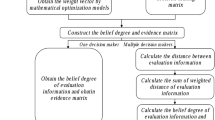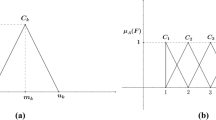Abstract
Information quality based on entropy is defined to measure uncertainty of a probability distribution, which is an important criterion in the field of data fusion. For given probability distributions, how to obtain the reasonable result of high quality is still an open issue. Especially when given probability distributions are highly conflicted, the result of applying classic data fusion method is counter-intuitive. In this paper, an optimal data fusion method on the basis of genetic algorithm is proposed to resolve this issue and the result with minimal Gini entropy within a reasonable range can be obtained. This method can handle the probabilistic fusion problem of given sources high conflict effectively and the Gini entropy of result is relatively small. Genetic algorithm is applied in this method to handle data fusion problem in this paper. The effectiveness of this proposed method is illustrated and the advantages of this method are analysed compared with other fusion methods.




Similar content being viewed by others
References
Yager RR (1988) On ordered weighted averaging aggregation operators in multicriteria decisionmaking. IEEE Trans Syst Man Cybern 18(1):183–190
Yager RR, Kacprzyk J (2012) The ordered weighted averaging operators: theory and applications. Springer Science & Business Media
Yager RR (2004) Modeling prioritized multicriteria decision making. IEEE Trans Syst Man Cybern Part B Cybern 34(6):2396–2404
Zhang L, Wu X, Zhu H, AbouRizk SM (2017) Perceiving safety risk of buildings adjacent to tunneling excavation: an information fusion approach. Autom Constr 73:88–101
Denoeux T, Sriboonchitta S, Kanjanatarakul O (2016) Evidential clustering of large dissimilarity data. Knowl-Based Syst 106:179–195
Yang J, Xu DL (2013) Evidential reasoning rule for evidence combination. Artif Intell 205:1–29
Jamalnia A, Yang J, Xu DL, Feili A (2017) Novel decision model based on mixed chase and level strategy for aggregate production planning under uncertainty: Case study in beverage industry. Comput Ind Eng 114:54–68
Zhang L, Wu X, Qin Y, Skibniewski MJ, Liu W (2016) Towards a fuzzy bayesian network based approach for safety risk analysis of Tunnel-Induced pipeline damage. Risk Anal 36(2):278–301
Ma J, Liu W, Miller P, Zhou H (2016) An evidential fusion approach for gender profiling. Inf Sci 333:10–20
He Z, Jiang W (2018) An evidential dynamical model to predict the interference effect of categorization on decision making results. Knowl-Based Syst 150:139–149
Deng X, Jiang W, Wang Z (2019) Zero-sum polymatrix games with link uncertainty: a dempster-shafer theory solution. Appl Math Comput 340:101–112
Hassan MM, Huda S, Yearwood J, Jelinek HF, Almogren A (2018) Multistage fusion approaches based on a generative model and multivariate exponentially weighted moving average for diagnosis of cardiovascular autonomic nerve dysfunction. Inf Fusion 41:105–118
Gravina R, Alinia P, Ghasemzadeh H, Fortino xG (2017) Multi-sensor fusion in body sensor networks: State-of-the-art and research challenges. Inf Fusion 35:68–80
Xiao F (2018) A hybrid fuzzy soft sets decision making method in medical diagnosis. IEEE Access 6:25300–25312
Geng H, Liang Y, Yang F, Xu L, Pan Q (2017) Model-reduced fault detection for multi-rate sensor fusion with unknown inputs. Inf Fusion 33:1–14
Yang J, Huang HZ, He LP, Zhu SP, Wen D (2011) Risk evaluation in failure mode and effects analysis of aircraft turbine rotor blades using Dempster–Shafer evidence theory under uncertainty. Eng Fail Anal 18 (8):2084–2092
Liu HC, Liu L, Lin QL (2013) Fuzzy failure mode and effects analysis using fuzzy evidential reasoning and belief rule-based methodology. IEEE Trans Reliab 62(1):23–36
Gong Y, Su X, Qian H, Yang N (2018) Research on fault diagnosis methods for the reactor coolant system of nuclear power plant based on DS evidence theory. Ann Nucl Energy 112:395–399
Cui H, Liu Q, Zhang J, Kang B (2019) An improved deng entropy and its application in pattern recognition. IEEE Access 7:18284–18292
He Z, Jiang W (2018) An evidential markov decision making model. Information Sciences 467:357–372
Sun R, Deng Y (2019) A new method to identify incomplete frame of discernment in evidence theory. IEEE Access 7:15547–15555
Yager RR, Alajlan N (2015) An intelligent interactive approach to group aggregation of subjective probabilities. Knowl-Based Syst 83:170–175
Song Y, Deng Y (2019) A new method to measure the divergence in evidential sensor data fusion. International Journal of Distributed Sensor Networks 15(4). https://doi.org/10.1177/1550147719841295
Fu C, Yang J, Yang SL (2015) A group evidential reasoning approach based on expert reliability. Eur J Oper Res 246(3):886–893
Deng X, Jiang W (2018) Dependence assessment in human reliability analysis using an evidential network approach extended by belief rules and uncertainty measures. Ann Nucl Energy 117:183–193
Jiang W, Xie C, Zhuang M, Tang Y (2017) Failure Mode and Effects Analysis based on a novel fuzzy evidential method. Appl Soft Comput 57:672–683
Huang Z, Yang L, Jiang W (2019) Uncertainty measurement with belief entropy on the interference effect in the quantum-like bayesian networks. Appl Math Comput 347:417–428
Deng X, Jiang W (2019) D number theory based game-theoretic framework in adversarial decision making under a fuzzy environment. Int J Approx Reason 106:194–213
Yang Y, Han D (2016) A new distance-based total uncertainty measure in the theory of belief functions. Knowl-Based Syst 94:114–123
Song Y, Wang X (2017) A new similarity measure between intuitionistic fuzzy sets and the positive definiteness of the similarity matrix. Pattern Anal Applic 20(1):215–226
Deng X (2018) Analyzing the monotonicity of belief interval based uncertainty measures in belief function theory. Int J Intell Syst 33(9):1869–1879
Mitchell M (1998) An introduction to genetic algorithms. MIT press, New York
Yılmaz ÖF, Pardalos PM (2017) Minimizing average lead time for the coordinated scheduling problem in a two-stage supply chain with multiple customers and multiple manufacturers. Comput Ind Eng 114:244–257
Wang HK, Chien CF, Chou CW (2017) An empirical study of bio manufacturing for the scheduling of hepatitis in vitro diagnostic device with constrained process time window. Comput Ind Eng 114:31–44
Wang Z, Leung KS, Wang J (1999) A genetic algorithm for determining nonadditive set functions in information fusion. Fuzzy Sets Syst 102(3):463–469
Liu W, Lu Y, Fu JS (2002) Data fusion of multiradar system by using genetic algorithm. IEEE Trans Aerosp Electron Syst 38(2):601–612
Kuckertz P, Ansari J, Riihijarvi J, Mahonen P (2007) Sniper fire localization using wireless sensor networks and genetic algorithm based data fusion. In: MILCOM 2007. IEEE Military communications conference. IEEE, pp 1–8
Sasiadek JZ (2002) Sensor fusion. Ann Rev Control 26(2):203–228
Sastry K, Goldberg DE, Kendall G (2014) Genetic algorithms. In: Search methodologies. Springer, pp 93–117
Das S, Panigrahi BK (2009) Multi-objective evolutionary algorithms. In: Encyclopedia of artificial intelligence. IGI Global, pp 1145–1151
Yager RR, Petry F (2016) An intelligent quality-based approach to fusing multi-source probabilistic information. Inf Fusion 31:127–136
Lefevre E, Colot O, Vannoorenberghe P (2002) Belief function combination and conflict management. Inf Fusion 3(2):149–162
Yong D, WenKang S, ZhenFu Z, Qi L (2004) Combining belief functions based on distance of evidence. Decis Support Syst 38(3):489–493
Jiang W (2018) A correlation coefficient for belief functions. Int J Approx Reason 103:94–106
Acknowledgements
The work is partially supported by National Natural Science Foundation of China (Program Nos. 61703338, 61671384), Natural Science Basic Research Plan in Shaanxi Province of China (Program No. 2016JM6018).
Author information
Authors and Affiliations
Corresponding author
Additional information
Publisher’s note
Springer Nature remains neutral with regard to jurisdictional claims in published maps and institutional affiliations.
Rights and permissions
About this article
Cite this article
Liang, S., Deng, X. & Jiang, W. Optimal data fusion based on information quality function. Appl Intell 49, 3938–3946 (2019). https://doi.org/10.1007/s10489-019-01494-5
Published:
Issue Date:
DOI: https://doi.org/10.1007/s10489-019-01494-5




